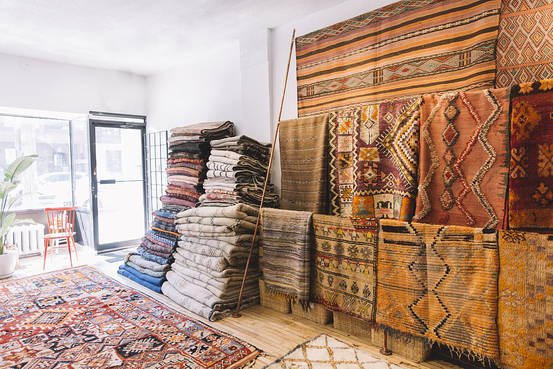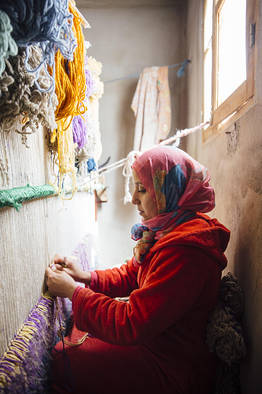Barron’s
Brent Crane
Moroccan rugs—intricate, infinitely varied, rich with symbolism and cultural depth—are quite like Morocco itself. The country of 35 million occupies a unique geographical space, squeezed between three great natural bodies–the Mediterranean, the Atlantic and the Sahara–and two continents, Europe and Africa. It holds a lot of surprises.
Speaking from his storefront on College Street in Toronto, Honeyman had recently returned from his seventh trip, traveling with two friends to source vintage rugs in the bigger cities of Fes, Marrakech, and Tangier. Most of Mellah’s rugs, though, are made by an all-women cooperative in the Middle Atlas Mountains, which Honeyman and his wife and Mellah co-founder Miriam, 36, first visited three years ago. They had been traveling “on sabbatical,” says Honeyman, after living and working for several years in New York City. They had surfed in Portugal and Spain, and Morocco had first interested them for its promising waves. But it was the mountains that ultimately attracted them. Then, of course, the textiles.
The Item
Moroccan rugs, Honeyman says, can be divided into two categories: Arab and Berber, the two dominant ethnic groups in Morocco. The former tend to center around “symmetrical” designs, full of Islamic symbolism, while the Berber rugs are “more folk arty,” Honeyman says, an aesthetic “which fits in well with modern design and architecture.” Most of Mellah’s offerings are Berber. Some customers choose to hang them, but most use the rugs as floor coverings.
Most of Mellahs rugs are made by an all-women cooperative in the Middle Atlas Mountains. Mellah
Price
Mellah rugs range in price from a few hundred to several thousand dollars. Sizes range considerably as well. Their hottest seller is the Beni Ourain, a cream-colored category with diamond patterns and ultra soft texture. Lately, though, their brighter-colored vintage rugs have been selling well, Honeyman says—“dusty pink or terracotta, tangerine-orange colors.” Most of Mellah’s sales are still made in-store, though they are starting to sell more and more to the U.S., especially New York City, where the couple used to live. In an average week Mellah manages to sell around five to 10 rugs, Honeyman says. (Mellah also has a colorful Instagram account.)
Description
Mellah refers to the Jewish neighborhoods of Morocco where Jewish refugees resettled starting in the 15th century following the Spanish Reconquista. At the time Morocco’s royal family offered Jews a safe-haven and they were settled within the walls of the Kasbah, or royal palaces, where they would be granted official protection. Several are still around today. The Honeymans chose the name because they are both Jewish and “the history is a part of Morocco that many probably don’t know about,” Honeyman says.
What’s the Good?
From the beginning, the Honeymans wanted Mellah to be an ethical company. Through a rug dealer in Marrakech that they trusted, they found a rural women cooperative they could source from. The cooperative is in Khenifra, a town of 150,000 or so in the Middle Atlas Mountains, a historically remote and rugged part of the country. The dozen or so women, Honeyman says, “own the production facility together and make decisions together, from buying supplies to selling to the market.” In that way, he adds, “we’re not just enriching one guy who owns a rug factory, but the people who actually make them.”
What’s Next
“Right now we’re just kind of sitting pretty,” Honeyman says. They have toyed with the idea of importing other Moroccan goods, such as tiles, “but we’ve got two young kids at home and sales have been good. We haven’t been super ambitious to take on another responsibility,” he says. They may expand the store–it is quite cozy–and hire some staff, “but for the moment we’re really happy with what we have.”








